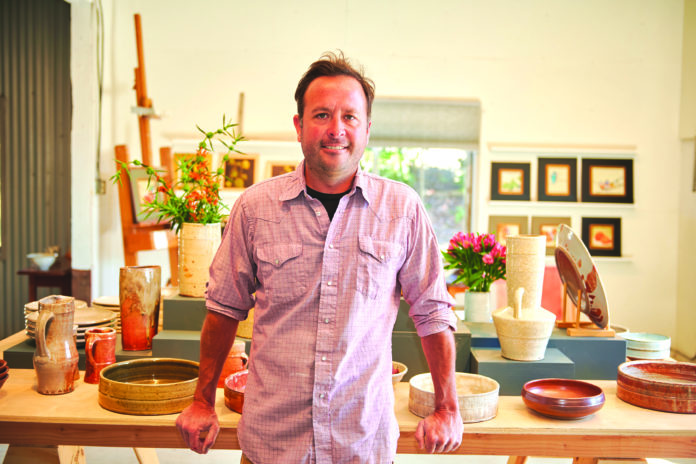It all started with a mug.
Santa Paula-based potter Nate Pidduck recalled the seemingly inauspicious moment that set him on his life’s path.
“Around 2003, while on a road trip to Zion National Park, I bought a mug from Greg Worthington’s gallery in Springdale, Utah, and found out it was thrown on a wheel … My friend explained it to me and I thought, ‘wow, that’s fascinating.’ I used the mug and just kept thinking about how it was made and who made it. I started to explore what that meant.”
This all happened at an opportune time, a few years after Pidduck graduated from University of California, Santa Barbara, with a degree in environmental studies.
“I just wanted to make stuff with my hands … I felt that that was what I was lacking. So, I looked into photography and ceramics night classes at Ventura College. Photography was all full so I took a ceramics class.”
Fate had dealt Pidduck a wonderful hand. While at Ventura College, he was influenced by instructors Myra Toth and Deanna Pini and studio manager Will Pettit. They introduced Pidduck to a world that was new to him and yet in some ways felt very familiar.
“The three of them were using a clay vocabulary that was new to me and I didn’t fully grasp what they were talking about,” Pidduck recalls, but there were also some things that he understood inherently — “like how a mug is the most intimate object we can make because you hold it. You cradle it, sometimes every day. You bring it to your lips … So, just to hear them talk about it, and with sparkling eyes. It seemed like, ‘oh, my gosh, this is what I’ve been feeling but I didn’t know how to articulate it or even if it was valid. They were validating everything through their work and through their practice and through what they were sharing. Meeting them sort of felt like it gave me permission to go forward with clay, which may sound weird. They are special people to me. It felt like, ‘Wow, I’m in the right place.’”
Clay, itself, drew Pidduck in. “It’s malleable,” he explains. “When the potter touches it, [clay] takes in all of those hand marks and holds [them] there … it holds a lot of information. I think that’s what I really liked about pottery from the beginning. Seeing those little marks left behind … I don’t know how I’ve made this connection, but I’ve always liked old tools. I have my grandpa’s hammer and it’s weathered and used. The handle’s shiny and … it tells his story and records him using it during his whole life as a builder.” Clay is the same way. “It holds stories.”
When asked if he always knew he wanted to be an artist, Pidduck responds, “I never had anything very clear like that, but I did like to make things. My mom [artist Gail Pidduck] would make our costumes growing up. She made birthday cards and illustrated books for us, so I saw that happening. My grandpa was a woodworker and so I saw that. I’d like to pretend when I was a kid and [I would] tinker and play.” And yet, Pidduck says, “I feel like it took me a long time to feel confident in what I was making in clay. [After] 15 years of practicing [ceramics] it’s neat to stand there and go, ‘Yeah, I made this,’ and to stand behind something. That’s a really wonderful feeling.”
While at Ventura College, his instructors encouraged Pidduck to challenge himself. “In a very positive, encouraging way, they’d be like, ‘You can do better.’ Or they’d ask me, ‘Is this the best you can do, Nate?’ … So, there was always that encouragement to think about, ‘Do you really want to put this out into the world? What’s the purpose of this? Do you really want this to last forever?’ Just because it’s handmade [doesn’t mean it’s] the end-all-be-all. There’s got to be more to it. Learning to think about that and to be critical of what you’re doing and why you’re doing it — I think that’s what has helped me make the items I’m making now.”
Pidduck took every class he could at Ventura College. He then began to set up his own studio in Santa Paula. Even after completing his studies, it was still some time before Pidduck felt confident enough to sell his work. “There was a lot of practicing before I could feel like I could sell it.”
In 2010, Pidduck moved to Chicago and began working at Lillstreet Art Center, where he made clay and taught classes. By the time he left in 2012, he was running the Soda Kiln Firing Program.
In 2012, he set up his own studio in a detached garage on his family’s Santa Paula ranch. His mother also has her studio on the property. “In 2015, we moved both studios to their current location, a larger building on the same property that houses both of our studios as well as a retail and gallery area.”
“After seeing other artists have success with an open studio/holiday sale, we decided to give it a try. Now in its 10th year, our open studio event is very popular. It’s on the Thursday and Friday after Thanksgiving and open to everyone.” (The year 2020 was an exception, of course, but hopefully in 2021, the Pidducks can resume the tradition.)
Before the pandemic, Pidduck would put a sign out on the road, letting people know that his studio was open to the public. For the time being, however, Pidduck’s studio is open by appointment only (natepidduck.com/studiogallery). His work is also available to purchase on his website.
“Lately, I have started doing a new body of work that is referred to as Kohiki.” Pidduck explains that Kohiki, a traditional Korean technique that was later adopted in Japan, is created by using “a dark iron-rich clay body and then putting a white slip on top of that and then a clear glaze on top of that. Through a unique firing sequence in a gas kiln, the iron breaks through the slip,” resulting in spots and “little peach-colored blushes … It’s very random. I am really intrigued by it. There’s an organic component to it that’s out of my control, so it keeps it interesting.”
Another technique that Pidduck has employed is salt firing, which involves throwing rock salt into the kiln at a high temperature. The salt reacts with the materials in the clay and the glazes. “You’ll get one side of the pot that’s shinier than the other,” he says. “In some ways it’s kind of like dancing a fine line between control and letting go.”
“It’s intriguing … I need the control in order to replicate and produce a product that is consistent and functional because people like to buy sets of things. I personally like reproducing things. I think I find comfort in that … but I’m also putting in a handful of these slipware pots.”
Control is an interesting word to use when speaking about pottery. After all, as Pidduck explains, things can go wrong at any moment.
“There’s so many stages where something can go wrong with a pot before it’s finished. It’s just learning to let go. If it doesn’t work, it doesn’t work. We have expectations each time we open a kiln. I think I’m getting better at not having those expectations or being so rigid. I just kind of enjoy the moment.”
Impermanence is part of the story. Pidduck reasons that if a mug, plate or bowl breaks, that means it’s being used — and that’s the whole point. He creates pieces to be used and enjoyed, not solely to be admired or sit on a shelf.
Unfortunately, Pidduck’s own lovingly-used mug, the one that inspired him to be a potter in the first place, met with a terrible fate: “I had it in my car and when I opened the door, it fell out and broke.”
He loved the mug so much that he got a replacement one from the same gallery. “It looked like the same mug. It was the same shape. It was the same maker. He makes tons of these mugs. It was the same everything, but I picked it up and it was like, ‘huh, this isn’t the same mug.’ It was a neat lesson. Like, what was so [special] about the other mug? Was it because of the moment I bought it? Was it the trip I was on? Or the people I was with? Or did I pick that mug because it felt the best in my hand, and why did it feel good? Was the weight a little more balanced? Was the handle a tiny bit different? It made me realize all the little things in a pot that can make a big difference.”
“I love it when people come [to the studio] and they will pick up like 20 mugs before they choose one. I know what they’re doing. They are finding that connection. It’s hard to explain. It’s very personal. I totally get it, and I feel so lucky to be a part of it.”































